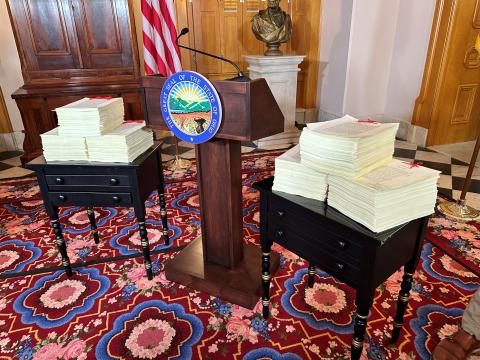A private group is handling Ohio's opioid settlement money. What does that mean for transparency?

Listen to this Episode
Last week Gov. Mike DeWine signed the two-year state budget. It included a line item that exempts the OneOhio Recovery Foundation from public records and meeting laws. The foundation oversees the spending of $1.1 billion of the state’s opioid overdose settlement money.
The change comes after the Ohio Supreme Court ruled earlier this year that the foundation was functionally a public entity and subject to sunshine laws.
Taylor Wizner with The Ohio Newsroom member station Ideastream Public Media joined Today from The Ohio Newsroom to explain the change.
The legal battle
“It started as a court fight. Harm Reduction Ohio’s president Dennis Couchon was trying to access some of the public meetings that this foundation was holding and found out that they were meeting in secret and not releasing minutes or details about what they were discussing in the meetings.
So he sued and the supreme court agreed with him and mandated that they start complying with public records requests and open meetings laws. But basically that all changed last week when the governor signed into law the new budget which basically reverses that, so that the foundation can now act as a private entity and [is] subject to different rules.”
The definition change
“The foundation says that they are going to continue to be transparent, they’ve released public records requests in the past and they say they’re going to continue to do that, but it’s really up to them what meetings they want to decide to have open or not. I reached out to the Ohio Senate leadership to ask why the foundation wanted to act like a private organization. I haven’t heard back from them. I also reached out to the foundation and they didn’t explain why either.”
Advocates’ concern
“The opioid settlement money was really paid in order to compensate for the overdose deaths of Ohio residents. The money is supposed to be spent for treatment programs but the foundation has indicated that it may be a little more liberal with that, so it remains to be seen exactly how that money will be spent.
There’s also this history with the tobacco settlements in the ‘90s, where over $245 billion was given to states and less than 3% of every dollar went to cessation and prevention programs. So there’s concern of falling into old ways.”
The next steps
“The board’s next meeting is later this month and advocates say it’s an important time to watch because starting this fall, they’re going to start distributing money and that could be distributed over multi-year grants. They say now is an important time to see how we start distributing that, even though this money, of course, will be spent over 18 years.”
9(MDYwODMwNTczMDE2ODk5NTExNDAyNzM5Ng000))
- Home
- Schedules
- TV
- TV
- Local TV Programs
- Business | Life 360 with Kristi K.
- Toledo Stories
- To The Point with Doni Miller
- Listening with Keith Burris
- Ideas & Insights
- WGTE Presents
- BL360: Northwest Ohio Innovation Consortium
- Magic of the Old West End
- Freedom Means Never Surrender
- I&I: The Random Factor
- FF: National Cherry Festival
- TTP: Moms Demand Action For Gun Sense in America
- Watch Live
- Radio
- Education
- Community
- Support
- About
- Donate
- Watch Live


